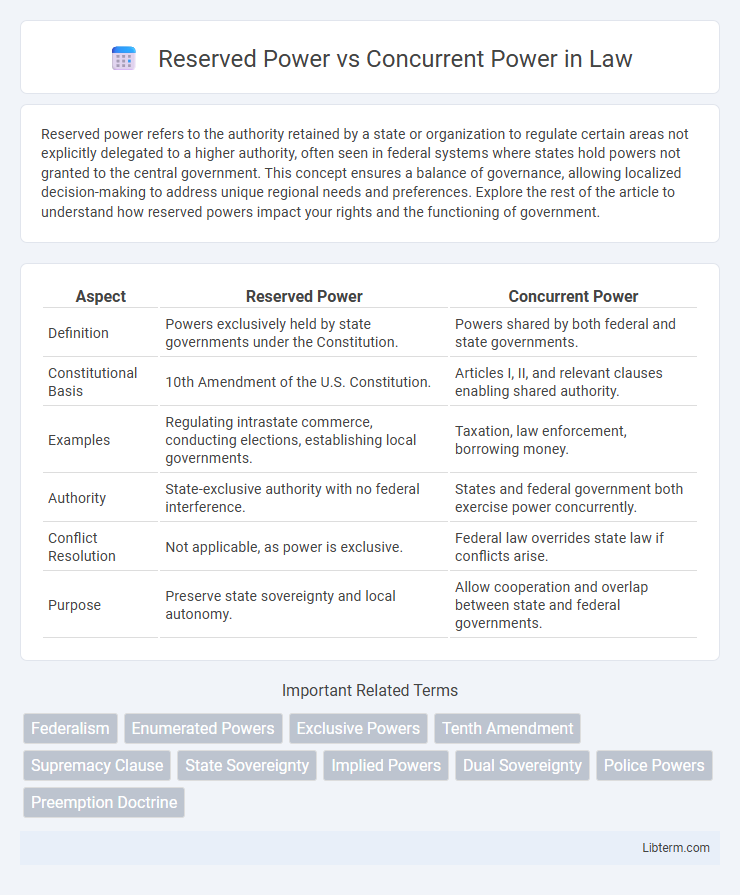Reserved power refers to the authority retained by a state or organization to regulate certain areas not explicitly delegated to a higher authority, often seen in federal systems where states hold powers not granted to the central government. This concept ensures a balance of governance, allowing localized decision-making to address unique regional needs and preferences. Explore the rest of the article to understand how reserved powers impact your rights and the functioning of government.
Table of Comparison
| Aspect | Reserved Power | Concurrent Power |
|---|---|---|
| Definition | Powers exclusively held by state governments under the Constitution. | Powers shared by both federal and state governments. |
| Constitutional Basis | 10th Amendment of the U.S. Constitution. | Articles I, II, and relevant clauses enabling shared authority. |
| Examples | Regulating intrastate commerce, conducting elections, establishing local governments. | Taxation, law enforcement, borrowing money. |
| Authority | State-exclusive authority with no federal interference. | States and federal government both exercise power concurrently. |
| Conflict Resolution | Not applicable, as power is exclusive. | Federal law overrides state law if conflicts arise. |
| Purpose | Preserve state sovereignty and local autonomy. | Allow cooperation and overlap between state and federal governments. |
Understanding Reserved Power
Reserved powers refer to those authorities that are specifically retained by the states under the Tenth Amendment of the U.S. Constitution, allowing state governments to legislate and govern in areas not explicitly assigned to the federal government. These powers include regulating intrastate commerce, conducting elections, and overseeing local government operations, which enable states to address regional needs and preferences effectively. Understanding reserved power is crucial to recognizing the balance of federalism that limits federal intrusion and preserves state sovereignty within the American political system.
Defining Concurrent Power
Concurrent power refers to the authority shared by both federal and state governments to legislate and regulate in certain areas, such as taxation, law enforcement, and infrastructure. This overlapping jurisdiction enables coordination in policy implementation while maintaining a balance of power within the federal system. Reserved power, in contrast, encompasses the exclusive rights retained by states to govern matters not explicitly assigned to the federal government by the Constitution.
Key Differences Between Reserved and Concurrent Powers
Reserved powers are constitutionally assigned exclusively to state governments, such as regulating intrastate commerce and establishing local governments, whereas concurrent powers are shared by both state and federal governments, including the authority to tax and enforce laws. Reserved powers originate from the Tenth Amendment, emphasizing state sovereignty, while concurrent powers enable cooperation and overlap in governance functions. The key distinction lies in exclusivity: reserved powers restrict federal interference, while concurrent powers allow simultaneous exercise by both government levels.
Historical Background of Constitutional Powers
Reserved powers, rooted in the Tenth Amendment of the U.S. Constitution, historically emerged to ensure states retained authority over matters not explicitly delegated to the federal government, reinforcing the principle of federalism. Concurrent powers have their origins in early American governance, allowing both state and federal governments to exercise authority simultaneously, such as taxation and law enforcement. This balance of constitutional powers reflects the framers' intent to allocate governance responsibilities between different levels, maintaining state sovereignty while enabling national unity.
Examples of Reserved Powers
Reserved powers refer to authorities exclusively held by state governments, such as regulating intrastate commerce, conducting elections, establishing local governments, and overseeing public education systems. These powers are distinguished from concurrent powers, which are shared by federal and state governments, like taxation and law enforcement. Examples of reserved powers emphasize state autonomy in areas like issuing professional licenses, managing health and safety regulations, and controlling state infrastructure development.
Examples of Concurrent Powers
Concurrent powers, shared by both state and federal governments, include the authority to levy taxes, establish courts, and enforce laws. For instance, both levels of government collect income taxes and maintain police forces to uphold public safety. These powers enable cooperation and overlap in governance, unlike reserved powers which are solely held by states.
Impact on Federal and State Relations
Reserved powers, defined under the Tenth Amendment, grant states authority over areas not explicitly delegated to the federal government, reinforcing state sovereignty and local governance. Concurrent powers, shared by both federal and state governments, create a framework for cooperation but can also lead to jurisdictional conflicts and legal ambiguities. The dynamic interplay between reserved and concurrent powers shapes federalism by balancing centralized authority with states' ability to address regional needs independently.
Constitutional Disputes: Reserved vs Concurrent Powers
Reserved powers, held exclusively by state governments under the Tenth Amendment, often lead to constitutional disputes when states enact laws conflicting with federal policies. Concurrent powers, shared by both federal and state governments, can create legal ambiguities regarding authority in areas like taxation and law enforcement. Courts, including the Supreme Court, frequently resolve these disputes by interpreting the Supremacy Clause and evaluating the balance of power established by the Constitution.
Importance of Power Separation in Governance
Reserved powers, held exclusively by state governments, and concurrent powers, shared between federal and state authorities, exemplify the critical principle of power separation in governance, ensuring balanced authority and preventing centralization. This division safeguards federalism by allowing states to address local needs independently while enabling collaboration on nationwide issues through concurrent powers like taxation. Maintaining distinct spheres of power strengthens democratic accountability and curtails the risk of authoritarian rule by distributing responsibilities across multiple government levels.
Future Trends in Power Distribution
Reserved powers, held exclusively by state governments under the Tenth Amendment, are increasingly leveraged for localized innovation in areas like education and environmental regulation, reflecting a trend toward greater state autonomy. Concurrent powers, shared between federal and state governments, are evolving with enhanced cooperation on public health and infrastructure, driven by emerging challenges such as climate change and cybersecurity. Future trends indicate a dynamic balance where technological advancements and shifting political priorities will continue to redefine the scope and interaction of reserved and concurrent powers.
Reserved Power Infographic

 libterm.com
libterm.com